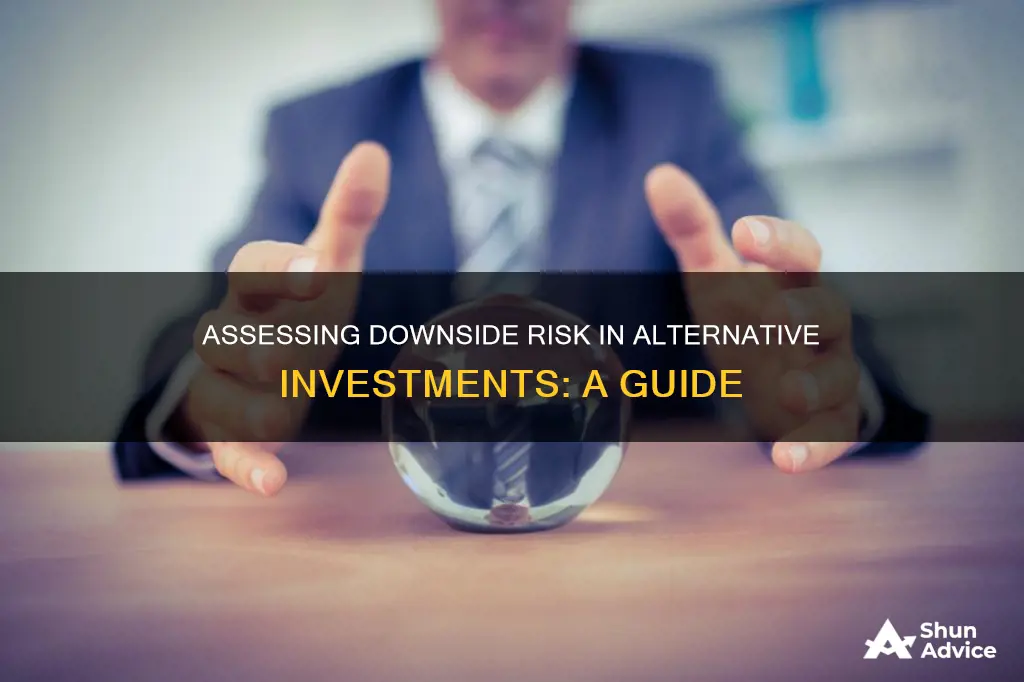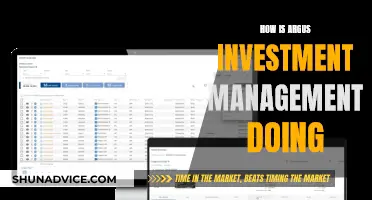
Alternative investments are financial assets that do not fall into conventional investment categories such as stocks, bonds, or cash. They can include private equity, hedge funds, commodities, and collectibles. These types of investments typically have a higher risk profile than traditional investments, which may not be suitable for all investors. Downside risk is an estimation of a security's potential loss in value if market conditions cause a decline in that security's price. It is important for investors to understand how to assess the downside risk of an alternative investment to make informed decisions and avoid potential losses.
| Characteristics | Values |
|---|---|
| Definition | An alternative investment is a financial asset that does not fall into one of the conventional investment categories. |
| Examples | Private equity, hedge funds, real property, commodities, cryptocurrency, and collectibles. |
| Risk | Alternative investments are considered riskier than traditional investments. |
| Regulation | Alternative investments are subject to less regulation than traditional investments. |
| Complexity | Alternative investments are more complex than traditional investments. |
| Returns | Alternative investments have the potential for higher returns than traditional investments. |
| Diversification | Alternative investments can be used to diversify a portfolio and reduce overall portfolio risk. |
| Fees | Alternative investments often have higher fees and minimum investment requirements than traditional investments. |
| Liquidity | Alternative investments are generally less liquid than traditional investments. |

Lack of transparency
Alternative investments are financial assets that do not fall into conventional investment categories such as stocks, bonds, or cash. They include private equity, venture capital, hedge funds, real estate, commodities, and more.
One of the key downsides of alternative investments is the lack of transparency. This means that investors may have limited visibility into the inner workings of the investment, making it difficult to assess risks and potential returns. This is in contrast to publicly traded securities, which are subject to stricter regulatory requirements and provide more information to investors.
The lack of transparency in alternative investments can be attributed to several factors:
- Complexity of Private Funds: There are different reporting metrics for the various types of private funds. For example, the performance metrics shown to investors in a hedge fund should differ from those reported for less liquid vehicles like private equity funds. Additionally, investments in alternatives can take the form of limited partnerships, co-investments, and direct holdings, further complicating transparency.
- Outdated Technologies: Many widely used technologies for portfolio and investor-level accounting lack Application Programming Interfaces (APIs), preventing data integration and restricting its usefulness and portability. This curtails the ability to provide transparency to investors as it limits the necessary analysis, aggregation, and modern presentation of data.
- Lack of Leadership and Reporting Standardization: There is a lack of uniform reporting standards within the alternative investment industry. While increased regulation and the presence of organizations like the Institutional Limited Partners Association have improved standards, there is no single reporting standard across all types of private funds. The party responsible for delivering transparency is also unclear.
To address these challenges, the alternative investment industry must evolve and adapt. This includes moving towards true digital reporting, embracing new technologies, and fund administrators taking on a stronger leadership role to improve the overall quality of service to clients.
Strategies to Diversify Your Investment Portfolio Wisely
You may want to see also

Higher fees
Alternative investments often have higher fees and expenses compared to traditional investments. Private equity and hedge funds, for example, typically charge high management and performance fees, which can significantly reduce investors' returns. These fees are usually two-fold: management fees and performance fees. Management fees are typically calculated as a fixed percentage of assets under management (AUM), while performance fees are based on a percentage of periodic fund returns. The management fee for hedge funds and REITs is usually based on assets under management, while private equity funds often apply this fee to committed capital.
Performance fees are a mechanism to reward fund managers for achieving returns above a specified baseline, known as the 'hurdle rate'. There are two types of hurdle rates: hard and soft. With a hard hurdle rate, the manager only earns fees on the portion of returns that exceed the hurdle rate, whereas with a soft hurdle rate, the manager earns fees on the entire return once the hurdle is surpassed.
In addition to management and performance fees, alternative investments may also have high upfront investment fees and high minimum investment requirements. For example, private equity investments typically involve buying shares in a private company or a group of companies, which can be costly.
It is important to note that transaction costs for alternative investments are typically lower than those of conventional assets due to lower levels of turnover. However, the complex nature of alternative investments means that they often have more complex compensation structures, which can affect the returns for investors.
Is Your Investment Safe? Spotting Risks and Red Flags
You may want to see also

Risk of fraud
Alternative investments are prone to investment scams and fraud due to the lack of regulations. They are often subject to a less clear legal structure than conventional investments. Alternative investments fall under the purview of the Dodd-Frank Wall Street Reform and Consumer Protection Act and are examined by the U.S. Securities and Exchange Commission (SEC). However, they are not required to register with the SEC and are therefore not overseen or regulated by them in the same way that mutual funds and ETFs are.
As a result, investors must conduct extensive due diligence when considering alternative investments. In some cases, only accredited investors—those with a net worth exceeding $1 million or an annual income of at least $200,000—may invest in alternative offerings.
Investment fraud, sometimes known as securities fraud, involves criminals duping victims into investing money into fraudulent projects or fictitious assets. These scams may include pyramid or Ponzi schemes, high-yield investment fraud, "pump and dump" schemes, advance fee schemes, real estate investment fraud, or schemes involving precious metals and coins.
Cryptocurrency investment fraud is becoming increasingly prevalent and is easily perpetrated using social media and communications applications. Cryptocurrency investment schemes, such as pig butchering, are lucrative for scammers and have victimised millions of Americans.
To protect yourself from investment fraud:
- Be wary of unsolicited contact via telephone, text message, email, social media, or in person, regarding investment opportunities.
- Avoid investments that sound "too good to be true" or are advertised as having high rates of return with little or "no risk".
- Do not pay a fee to unlock access to an investment opportunity.
- Do not provide sensitive information such as your social security number or bank account details, and do not give in to high-pressure tactics to force you to invest.
- Consult the websites of federal and state regulatory authorities and online corporate records concerning any proposed investment, investment firm, or anyone representing themselves as a broker.
- Request to review financial statements, annual reports, or audit results for any proposed investment.
- Avoid projects that do not involve the sale of products or services and instead involve you earning money by recruiting others to invest.
- Always question the legitimacy of any cryptocurrency investment project advertising itself as "the next big thing".
Risk Varies: Not All Investments Are Created Equal
You may want to see also

Illiquidity
The level of liquidity in alternative investments can vary, ranging from highly liquid to semi-liquid or illiquid. Highly liquid alternative investments, such as stocks or ETFs, trade frequently and can be easily converted to cash. Semi-liquid or intermittently liquid alternatives offer limited opportunities to access investments at certain times, providing a balance between liquidity and access to private markets. Illiquid alternatives, on the other hand, do not offer frequent pricing or public transparency and typically invest solely through private markets.
The illiquidity of alternative investments can have both advantages and disadvantages. On the one hand, it can allow investors more time to execute their strategies, pursue opportunities, and influence company management and operations. It can also enable investors to exit investments on more favorable terms. However, illiquid investments may be challenging to convert to cash quickly and may require significant fees or lock-up periods.
When considering alternative investments, investors should carefully weigh the benefits and risks associated with different levels of liquidity. Illiquid alternatives may offer higher returns but also carry the risk of not being able to take advantage of other opportunities that arise. Additionally, they may have investor restrictions on liquidity, employ leverage, and have unique risks associated with their investment strategies.
In summary, illiquidity is an important aspect of alternative investments, and it can impact an investor's ability to access and exit investments. While it can provide certain benefits, it also carries risks that should be carefully considered as part of the overall investment strategy and risk assessment.
Saving and Investment: Understanding the Fundamentals
You may want to see also

High minimum investment
Alternative investments are often associated with high minimum investments. This is due to their complex nature, lack of regulation, and degree of risk. They are typically held by institutional investors or accredited, high-net-worth individuals.
The high minimum investment amount can be a barrier for smaller investors, preventing them from accessing certain alternative investment opportunities. This exclusivity is a defining feature of alternative investments, setting them apart from traditional investments such as stocks, bonds, and mutual funds, which have lower minimum investment requirements.
The high minimum investment is often justified by the higher fees and costs associated with alternative investments. These investments may have complex fee structures, including upfront investment fees and management fees, which can significantly reduce investors' returns.
Additionally, alternative investments tend to have lower transaction costs compared to conventional assets due to lower levels of turnover. This partially offsets the impact of the high minimum investment amount.
The high minimum investment characteristic of alternative investments is an important consideration for investors. It limits the accessibility of these investments and underscores the need for thorough due diligence and an understanding of the associated risks and complexities.
Building an Investment Portfolio: A Comprehensive Guide
You may want to see also
Frequently asked questions
Downside risk is the estimation of a security's potential loss in value if market conditions cause a decline in that security's price. It indicates the worst-case scenario for an investment and how much the investor stands to lose.
Downside risk represents the potential loss in value of a security in the short term due to market or economic events. Standard risk, on the other hand, refers to the chance of a security increasing or decreasing in value over time.
Common measures of downside risk include semi-deviation, value-at-risk (VaR), and Roy's Safety First ratio (SFRatio). Semi-deviation focuses on negative returns and is useful for investors concerned about potential losses. VaR estimates the potential loss of a company's portfolio of investments over a given period. SFRatio evaluates portfolios based on the probability that their returns will fall below a minimum desired threshold.
Alternative investments fall outside traditional investment categories such as stocks, bonds, or cash. They include private equity, hedge funds, commodities, real estate, and collectibles. These investments typically offer higher potential returns but carry a higher risk profile than traditional investments.
Alternative investments are often more complex, illiquid, and unregulated compared to traditional investments. They may have higher fees, lack transparency, and be challenging to value accurately. Due to their high-risk nature, they may not be suitable for all investors.







